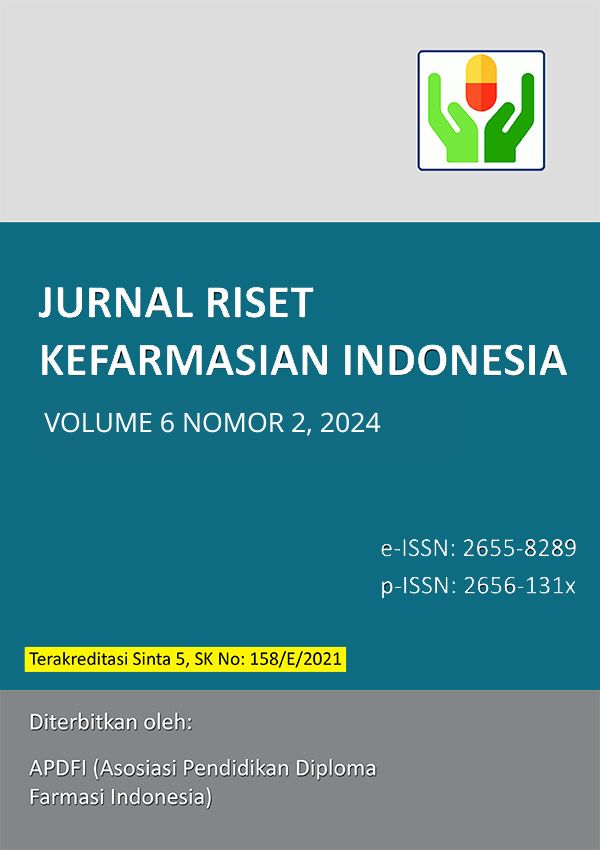EFISIENSI SISTEM PENYIMPANAN OBAT DI BEBERAPA PUSKESMAS DAERAH YOGYAKARTA
DOI:
https://doi.org/10.33759/jrki.v6i2.521Abstract
Medicine storage is an activity to ensure that the medicines received are placed in a place that is considered safe, which includes 3 elements, namely spatial planning and preparation of the medicine warehouse, safeguarding the quality of medicines, and recording medicine stock. Medication storage errors can cause drug shortages, losses due to lost or damaged and expired drugs, and also result in the potency of a drug decreasing which then results in it being ineffective if consumed by the patient. The aim of this research is to determine the suitability of drug storage and determine the efficiency of drug storage at the Sleman Health Center, Yogyakarta City and Bantul. This research is non-experimental research, with a descriptive qualitative research type and design. The results of research on drug storage in the three community health centers meet the standards in the "Very Good" category based on the Pharmaceutical Management Training Materials in Community Health Centers published by the Ministry of Health in 2010, as well as technical instructions for pharmaceutical service standards in Community Health Centers from the Ministry of Health in 2019. Results of drug storage efficiency Value The Turn Over Ratio (TOR) at the Sleman Community Health Center was 10.87 times, the Yogyakarta City Health Center 9.55 times and the Bantul Community Health Center 11.33 times. The percentage of expired and damaged medicines at the Sleman Community Health Center was 5.33%, Yogyakarta City Health Center 7.5% and Bantul Community Health Center 3.63%. The percentage of dead stock medicines at the Sleman Community Health Center is 9.38%, the Yogyakarta City Health Center is 10.12% and the Bantul Community Health Center is 1.35%.
Downloads
References
Akbar, N. H., Kartinah, N., & Wijaya, C. (2016). Analisis Manajemen Penyimpanan Obat di Puskesmas Se-Kota Banjarbaru. Jurnal Manajemen Dan Pelayanan Farmasi, 6, 255–260.
Anggraini, C. (2013). Kajian Kesesuaian Penyimpanan Sediaan Obat pada Dua Puskesmas yang Berada di Kota Palangka Raya. In Jurnal Ilmiah Mahasiswa Universitas Surabaya: Vol. 2 No.2.
Anggraini, D., & Merlina, S. (2020). Analisis Sistem Penyimpanan Obat di Instalasi Farmasi Dinas Kesehatan Kabupaten Rokan Hulu Tahun 2018. In Pharmaceutical Journal of Indonesia (Vol. 17, Issue 01).
Astuti, F., Pitaloka, J., & Capritasari, R. (2021). Gambaran Sistem Penyimpanan Obat di Puskesmas Sewon 1. In Jurnal Farmasi: Vol. 5 No. 2 (Issue May).
Febreani, S. H., & Chalidyanto, D. (2016). Pengelolaan Sediaan Obat Pada Logistik Farmasi Rumah Sakit Umum Tipe B di Jawa Timur. In Jurnal Administrasi Kesehatan Indonesia (Vol. 4).
Dewi, R. M. (2021). Evaluasi Mutu Penyimpanan Obat Di Puskesmas Kecamatan Kasihan Kabupaten Bantul. Universitas Jenderal Achmad Yani Yogyakarta.
Dewi, V. C., & Yuswantina, R. (2022). Evaluasi Penyimpanan Obat di Gudang Farmasi Puskesmas Mangunsari Kota Salatiga. In Journal of Holistics and Health Science (Vol. 4, Issue 1). https://doi.org/10.35473/jhhs.v4i1.137
Husnawati, Lukman, A., & Ardyansyah, I. (2016). Implementasi Sistem Penyimpanan Obat di Puskesmas Rawat Inap Sidomulyo Kotamadya Pekanbaru. Scientia : Jurnal Farmasi Dan Kesehatan, 6, 7. https://doi.org/10.36434/scientia.v6i1.35
Kemenkes. (2014). Profil Kesehatan Indonesia Tahun 2014. Kementrian Kesehatan RI. http://www.kemkes.go.id
Kemenkes. (2019). Profil Kesehatan Indonesia Tahun 2019. Kementrian Kesehatan RI. http://www.kemkes.go.id
Khairani, R. N., Latifah, E., & Nila Septianingrum, N. M. A. (2021). Evaluasi Obat Kadaluwarsa, Obat Rusak dan Stok Mati di Puskesmas Wilayah Magelang. Jurnal Farmasi Dan Ilmu Kefarmasian Indonesia, 8(1), 91. https://doi.org/10.20473/jfiki.v8i12021.91-97
Negari, P. A. (2022). Evaluasi penyimpanan sediaan farmasi, alat kesehatan, bahan medis habis pakai di apotek uii farma tahun 2020 skripsi [UII]. https://dspace.uii.ac.id/bitstream/handle/123456789/38889/16613015.pdf?sequence=1&isAllowed=y
Oviani, G. A., & Indraswari, P. I. I. (2020). Tinjauan Penyimpanan Sediaan Farmasi Pada Instalasi Farmasi Rumah Sakit. In Acta Holistica Pharmaciana: Vol. 2 No. 2.
Pondaag, I. G., Sambou, C. N., Kanter, J. W., & Untu, S. D. (2020). Evaluasi Sistem Penyimpanan Obat di UPTD Instalasi Farmasi Kota Manado. In Jurnal Biofarmasetikal Tropis (Vol. 3, Issue 1).
Qiyaam, N., Furqoni, N., & Hariati. (2016). Evaluasi Manajemen Penyimpanan Obat di Gudang Obat Instalasi Farmasi Rumah Sakit Umum Daerah dr. R. Sedjono Selong Lombok Timur. In Jurnal Ilmiah Ibnu Sina (Vol. 1, Issue 1).
Rugiarti, N. D., Hidayati, A. N., Medisa, D., & Nugraheni, D. A. (2021). Evaluasi penyimpanan obat di Puskesmas “X” Kabupaten Sleman. Jurnal Ilmiah Farmasi, 17(1), 74–79. https://doi.org/10.20885/jif.vol17.iss1.art8
Satibi. (2014). Manajemen Obat Di Rumah Sakit. Farmasi UGM.
Satibi, Rokhman, M. R., & Aditama, H, (2016), Manajemen Apotek. Yogyakarta: Gadjah Mada University Press.
Sulistyowati, W. D., Restyana, A., & Yuniar, A. W. (2020). Evaluasi Pengelolaan Obat di Puskesmas Wilayah Kabupaten Jombang dan Faktor-Faktor yang Mempengaruhi. In Jurnal Inovasi Farmasi Indonesia (JAFI) (Vol. 1, Issue 2). https://doi.org/10.30737/jafi.v1i2.760
Downloads
Published
Issue
Section
License
Copyright (c) 2024 Jurnal Riset Kefarmasian Indonesia

This work is licensed under a Creative Commons Attribution-NonCommercial-ShareAlike 4.0 International License.












